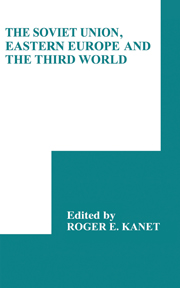Book contents
- Frontmatter
- Contents
- List of figures
- List of tables
- List of contributors
- Foreword by R.C. Elwood
- Preface by Roger E. Kanet
- PART 1 THE THIRD WORLD IN SOVIET FOREIGN POLICY
- 1 The Soviet Union and the Third World from Khrushchev to Gorbachev: the place of the Third World in evolving Soviet global strategy
- 2 Revolutionary change in the Third World: recent Soviet reassessments
- 3 Anti-Soviet insurgencies: growing trend or passing phase?
- 4 The Soviet Union and the New World Information Order
- 5 Soviet propaganda and the process of national liberation
- PART 2 CMEA ECONOMIC INVOLVEMENT IN THE THIRD WORLD
- PART 3 THE SOVIET UNION IN THE MIDDLE EAST AND SOUTH ASIA
- Index
- Publications from the Third World Congress for Soviet and East European Studies, Washington, 1985
4 - The Soviet Union and the New World Information Order
from PART 1 - THE THIRD WORLD IN SOVIET FOREIGN POLICY
Published online by Cambridge University Press: 06 July 2010
- Frontmatter
- Contents
- List of figures
- List of tables
- List of contributors
- Foreword by R.C. Elwood
- Preface by Roger E. Kanet
- PART 1 THE THIRD WORLD IN SOVIET FOREIGN POLICY
- 1 The Soviet Union and the Third World from Khrushchev to Gorbachev: the place of the Third World in evolving Soviet global strategy
- 2 Revolutionary change in the Third World: recent Soviet reassessments
- 3 Anti-Soviet insurgencies: growing trend or passing phase?
- 4 The Soviet Union and the New World Information Order
- 5 Soviet propaganda and the process of national liberation
- PART 2 CMEA ECONOMIC INVOLVEMENT IN THE THIRD WORLD
- PART 3 THE SOVIET UNION IN THE MIDDLE EAST AND SOUTH ASIA
- Index
- Publications from the Third World Congress for Soviet and East European Studies, Washington, 1985
Summary
The contours of the various models for a New World Information Order (NWIO) or a New World Information and Communication Order (NWICO) became clear only in the course of the debate concerning the issues involved. The fundamental outline, however, had already been established before the term “New World Information Order” emerged in the mid-1970s. The existing or desired communication system of a given developing nation or political system is offered as a model for World Information Order, projected across the globe. Before we turn to a full discussion of the subject, some frequently ignored truisms concerning the role of communications in human affairs must be emphasized:
human social life depends on the exchange of information, on communication;
throughout history information has not only consisted of messages, but has also constituted a means of exerting influence;
no one can report about everything that happens or about everything on which information is available;
possessing information is a prerequisite for exerting influence, for power and information are intimately interrelated; and
the domestic information and communication policy of a country and its foreign information and communication policy depend on the given political and social system.
SOVIET MEDIA POLICY
If we wish to present the development of the Soviet concept of a NWIO, then we must investigate basic Soviet policy towards the mass media. Since 1917 it has been guided by the three functions Lenin defined for the press: those of collective propagandist, collective agitator, and collective organizer.
- Type
- Chapter
- Information
- The Soviet Union, Eastern Europe and the Third World , pp. 70 - 83Publisher: Cambridge University PressPrint publication year: 1988



